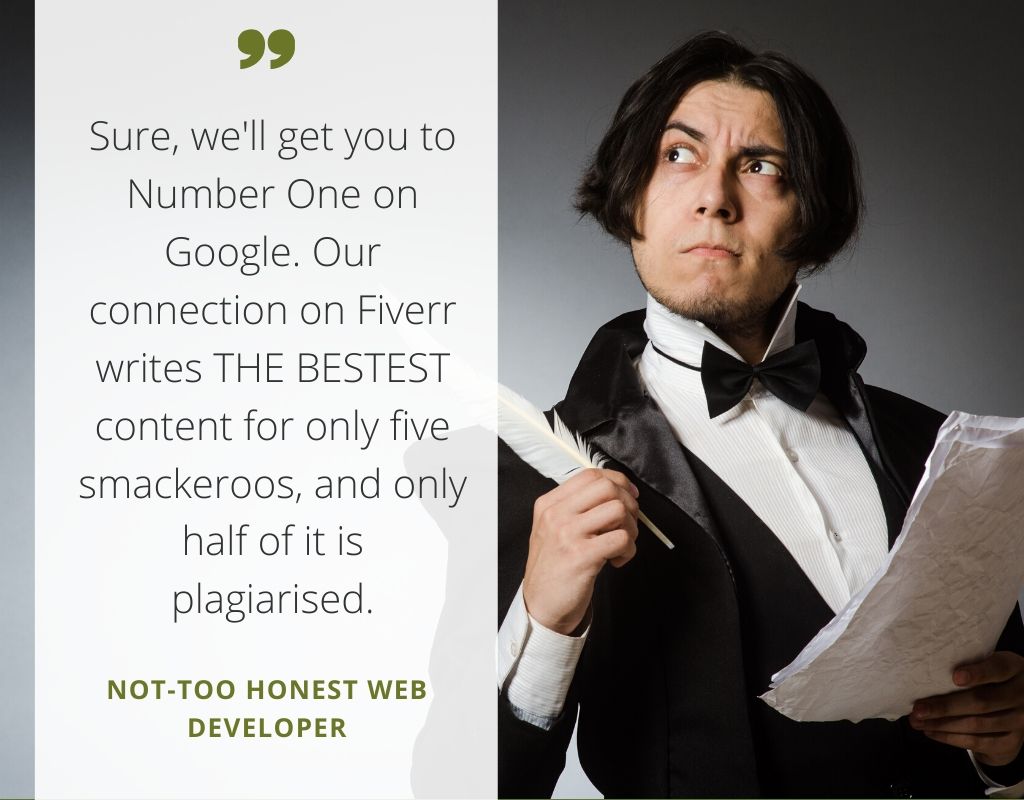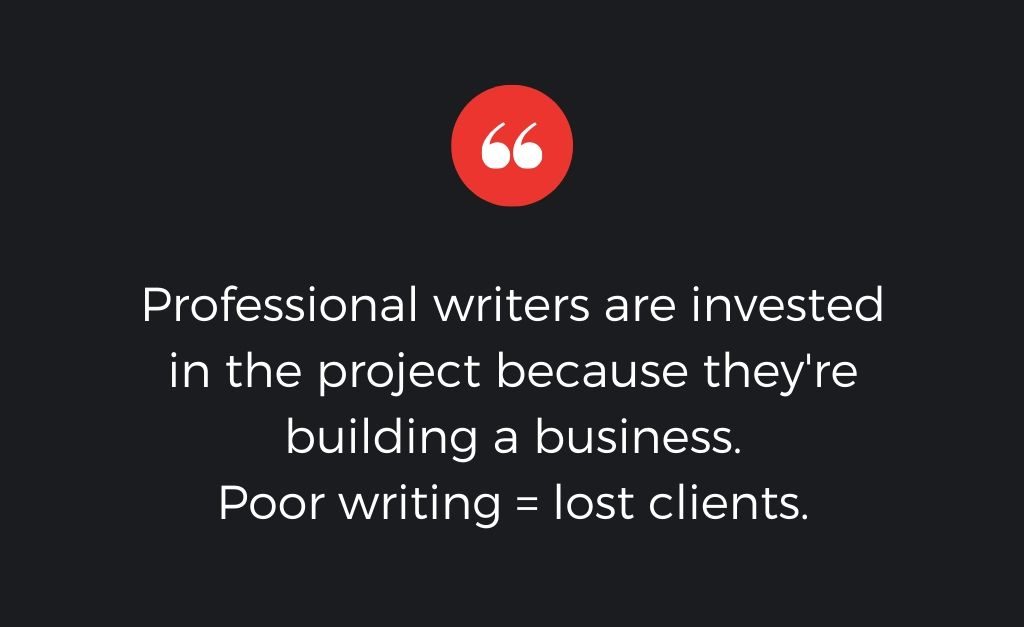Web designers have a tough time.
Competition in the industry is brutal and cutthroat. Dirt-cheap prices abound as a result of a saturated market. Even successful design agencies can go bust because clients can be overly demanding or “flat-out bonkers” when it comes to design.
I know the feeling. I used to be a web designer myself, back in the days of CSS2 and a Twitter-free world. (I wasn’t very good.)
Potential clients always wanted the same thing when discussing the deal with me:
“I want it to be Number One on Google!”
Sheesh.

I knew little of SEO back then, but I instinctively knew that great content drives traffic. I wasn’t yet a professional writer, so my solution was usually to develop some or other CMS and put the power into my clients’ hands to create that great content.
They rarely did.
I didn’t know why back then. But I do now.
Promoting content to web design clients is a hard sell
So, the lead comes to the agency and says, “Yeah, I want the site to look great, and I want it to” — drum roll, please — “be number one on Google!”
Sheesh. Doesn’t everyone?
You tell the guy, “Sure, we’ll implement all the best-practice recommendations from Google, and we’ll put it in your power to create excellent content for your site anytime you wish.”
And the client looks at you with a frown. “Yeah, but your competitor said I’d be Number One if I went with them, and they’re £100 cheaper.”
Liar! (Not the client, the competitor.)

You do some quick thinking. And the idea comes to you: Content mills!
“Okay, okay, sure,” you say, “fine, fine, fine, okay — we can’t guarantee Number One, but we can certainly give you top-quality content, ahem, at rock-bottom prices which gives you the best chances to get to that amazeballs Number One spot!”
Liar!
Content-mill writing just sucks, period
You know it, and I know it. The work produced by the vast majority of writers on content mills is freaking atrocious.
Likely some of the writers on there are good — maybe many of them are — but the gig economy structure of those sites virtually guarantees poor work. Job listings are uniformly insulting. Even if the writer wants to do a good job, they simply can’t because the rates don’t allow them to.

In the end, the only thing you’ll get from these sites is plagiarised content that isn’t worth the pennies you paid for it.
But your client wants you to provide the content…at dirt cheap prices.
So, what is a poor web design agency supposed to do?
In-house writers
The more prominent agencies have in-house content writers. But it’s generally out of bounds as an option for microbusinesses.
There are pros and cons to in-house writers.

Pros
- Fixed wage regardless of how many articles need to get written (this is also a con)
- Can’t “get away with” utterly awful content because the staff member is part of the team
Cons
- Typical employee issues — the writer might not be entirely invested in the client’s success, because they’ll get paid even if the content is poor
- Expensive to have around when work is slow
- Likely will get into the Content Mill mindset if there is too much work to be done, i.e. they’ll try to get content out as fast as possible to relieve the pressure of production, even if quality suffers
Professional Freelance writers
Note that I added the word professional.
These are the writers you’ll find by word of mouth, who have built client relationships, who take pride in their work and do that work to the highest quality standards at competitive prices.
Because they are building a business.

You will unlikely find these writers on freelance writer websites, and certainly not in any content mill.
There are two ways to go about hiring the writer:
- Outsourced/subcontracting, and the client never knows about it.
- Refer the client to the writer and let them get on with business themselves
Outsourced/subcontracting pros and cons
When outsourcing or subcontracting the work, the agency could charge a premium above the writer’s rate and so make a little extra dough. If the agency gives the writer regular work, the writer could even charge the agency a lower rate than usual.
The main con is that there could be a lot of back-and-forth for the writing project, and this adds time which the agency might or might not be able to bill for.
Articles requiring specialised knowledge or specific input from the client are the most likely to fall into this situation.
In such a saturated and competitive industry as web design, these additional hours of work might mean the difference between striking a profit for the month or not.

Referrals pros and cons
In a referrals scenario, the design agency can do what it does best and nothing else — design. This means they won’t get a cut from the writer’s work. (But this might be a blessing in disguise if there’s plenty of back and forth.)
Or, they could also come to an agreement on commissions, for example. For each successful referral, the agency could get paid, say, £100.
The other pro/con is that the writer’s work will reflect on the agency itself if they were the ones who made the referral. And I’m not only talking about the writing here. I’m talking about the writer’s general conduct and demeanour, his way of dealing with the client.
A professional writer would also be a successful business person. It’s imperative that whoever the agency finds to refer clients to is reliable and competent.
Writers should charge per word or per project
To avoid bad blood between the design agency and the client because of the writer, the agency should strive to work only with writers who charge per word or per project.

Charging per hour is a paradigm which simply does not work for either the writer or the client. It leads either to low-quality work or to high-quality work which is overpriced.
The best writers cost money, and serious clients will pay that money
Whether in writing or in any other business, there are many different types of clients.
As much as a design agency would like to put the client’s site on Number One, if the client is unwilling to fork over the dough, they’ll simply never get there.
It’s essential to enlighten a client on why getting to number one might require more investment.

But there are clients who simply will not listen to, or accept, any logical reasoning for this.
That’s business. And for those guys there are:
- Cheap websites
- Content mills
- Freelance writing sites
I do cheap(ish) work for people when I’m not too busy. I try not to do it too often because I have a personal rule that I will always deliver my best (within reason) no matter what price I quoted. And I don’t want to work like a dog for nothing.
In a utopian world, one would not have to deal with such clients. (They can be more trouble in the long run than not.) But we don’t live in a utopian world.
The other type of client is the one who understands SEO and is willing to pay for it.
These are the professional buyers who have done their homework and know a good product when they see one. Or they are buyers who have listened to your reasoning about the importance of content marketing and saw that it made sense.
It doesn’t mean those professional buyers will not haggle. It does mean that they will not be “flat-out bonkers” when discussing good work.
These clients are professionals. They do exist. You certainly won’t find them on any freelance writing website.




